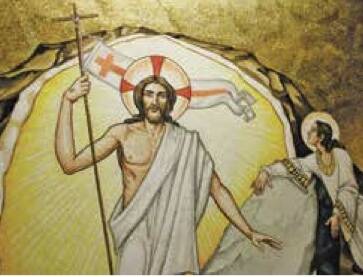The editors of America strive to ensure that our editorials, articles, blog posts and videos are not overly focused on the locale in which we live and work. Our magazine is called “America,” but our readership is worldwide, both in print and online. But as we look toward Easter and enjoy the first blooms of spring, we would be remiss not to note that many parts of the United States have just suffered through an unusually brutal winter. The “polar vortex,” which is said to occur only once every few centuries, seemed to visit many regions of our country every few weeks. Immense snowfalls, frigid temperatures and rivers of slush made this winter one that tens of millions of people desperately longed to see end.
At the same time, it awakened an almost primal desire for spring—its warmth, its colors, its life. “As the deer longs for streams of water,” the psalmist wrote, “so my soul longs for you, O God” (42:2). That sentiment expresses what many Americans felt about springtime this year.
That kind of deep longing mirrors the longing we feel for the coming of Christ. St. Bernard of Clairvaux, the 12th-century Cistercian writer, spoke of three comings of our Lord. The first is the coming of Jesus in history, the Messiah for whom the Hebrew people longed for centuries. God became human and entered into the world of first-century Palestine. Theologians sometimes call this the “scandal of particularity.” In him God entered the world at a particular time, in a particular place and with the cooperation of a particular woman.
The second of Bernard’s comings is the coming of Christ into our lives on a daily basis. All of us—like the psalmist’s deer, panting for water—long for a fuller relationship with God.
Finally, in the coming of Christ at the end of time and history, all our longings will be satisfied in an eternal spring.
To Bernard’s three comings one might add a fourth: the coming of Jesus out of the tomb. Imagine the inchoate longing of the disciples after the terrible events of Good Friday. One often tends to focus on the disciples’ sadness, or their fear, after the execution of their leader. But mingled with that sadness and fear must have been an intense longing for clarity and for consolation. “How could God,” they must have wondered, “bring something new out of this?” How the followers of Jesus must have ached for a warm answer to the cold reality of Good Friday. How they must have sought light after the darkness of his death. How they must have longed for something new.
It was not unreasonable for Jesus’ followers to conclude that everything was now over. Indeed, most of the disciples seem to have reached that conclusion even before Jesus’ death. When pressed, St. Peter denied ever having known Jesus. By the time of the crucifixion, all but a few women and the apostle John had slunk away. By all human measures, everything had ended.
Yet seeing with merely human eyes can mislead us, as it misled the disciples. During this worst of winters, it may have seemed impossible that the frozen ground could ever again yield anything as beautiful as a violet crocus or a yellow tulip or a blade of green grass. But God has other plans.
Renewal is the theme that one finds not only in nature, but also in the church today. In the year following the election of Pope Francis, many Catholics have experienced a decided sense of renewal and refreshment. Catholics who had at times felt unwelcome in the church—among them some women, divorced and remarried Catholics, and gays and lesbians—have reported experiencing a sense of newness. Other Catholics, who have long felt welcomed, nonetheless feel new warmth in the church. This is not to set aside the papacies of either soon-to-be St. John Paul II or Pope Emeritus Benedict XVI. Each pope brings his unique gifts to the office. But it would be foolish to deny that with Pope Francis God is doing something new.
The message of Easter is that Christ is risen. But the message is also that God can always bring new life from what appears to be dead. That God can bring hope out of despair. That God can bring love from a situation in which hatred seems to reign. That God can bring change when things seemed unchangeable. That God can, after the hardest winter in memory, still renew the face of the earth (Ps 104:30). Easter means spring in every area of life.
The message of Easter, in short, is that nothing is impossible with God. This is what the angel Gabriel told Mary at the Annunciation. In John’s Gospel the angels tell the women who have come to the tomb on Easter Sunday that same message, but in a new, different and entirely surprising way. They say: “He is risen!”








